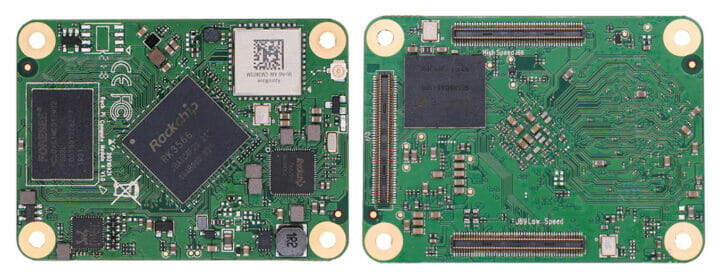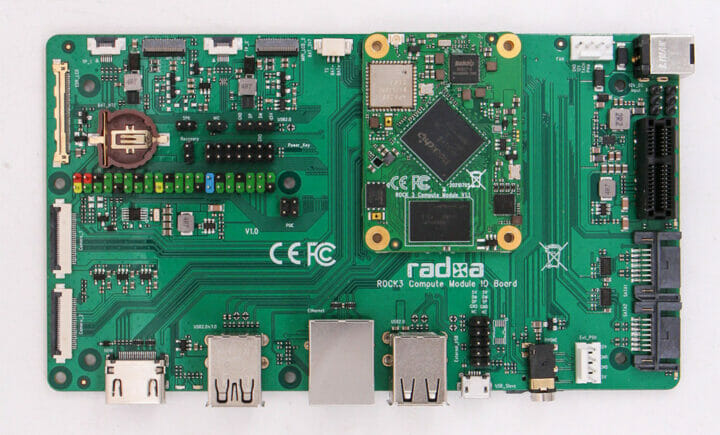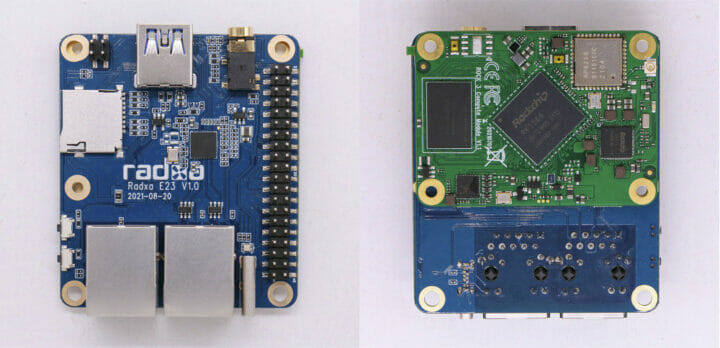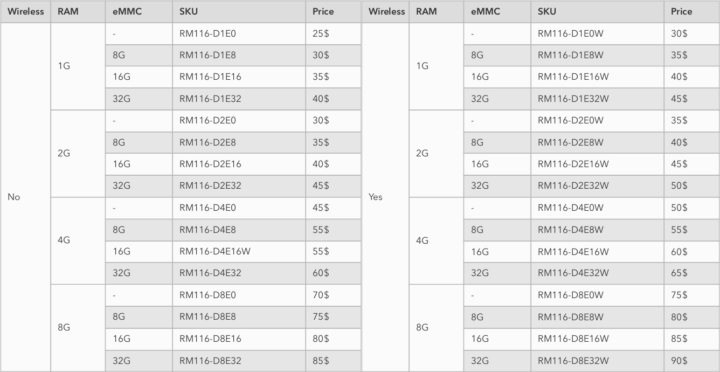Radxa CM3 is a system-on-module that offers an alternative to the Raspberry Pi CM4, with the same form factor allowing it to become a drop-in replacement, but switching from a Broadcom BCM2711 processor to a Rockchip RK3566 quad-core Cortex-A55 SoC.
Radxa CM3 will work with existing carrier boards for the Raspberry Pi Compute Module 4, albeit some features such as dual HDMI are not available, instead, providing a single HDMI, but the module also offers extra features through an additional 100-pin board-to-board with interfaces such as SATA III and USB 3.0.
 Let’s compare Radxa CM3 specifications to the ones of Raspberry Pi CM4.
Let’s compare Radxa CM3 specifications to the ones of Raspberry Pi CM4.
Radxa CM3 | Raspberry Pi CM4 |
|
|---|---|---|
| SoC | Rockchip RK3566 quad-core Cortex-A55 processor @ 2.0 GHz with Arm Mali-G52 2EE GPU, 0.8 TOPS AI accelerator | Broadcom BCM2711 quad-core Cortex-A72 processor @ 1.5 GHz with VideoCore VI GPU |
| System Memory | 1GB, 2GB, 4GB or 8GB LPDDR4-3200 SDRAM |
|
| Storage | None, 8GB, 16GB, 32GB, 64GB, 128GB eMMC Flash memory up to 250MB/s SDIO 3.0 | None, 8GB, 16GB, 32GB, 64GB, 128GB eMMC Flash memory up to 100MB/s SDIO 2.0 for CM4Lite only |
| Display interfaces | 1x HDMI up to 4K60 2x 4-lane MIPI DSI display interfaces 1x 4-lane LVDS multiplexed with 1x MIPI DSI 1x eDP up to 4K60 | 2x HDMI up to 4K60 1x 2-lane MIPI DSI display interface 1x 4-lane MIPI DSI display interface |
| Camera interfaces | 1x 2-lane MIPI CSI camera port 1x 4-lane MIPI CSI camera port |
|
| Audio codec | Yes | No (must be on carrier board) |
| Ethernet | Gigabit Ethernet PHY (RTL8211F) with optional IEEE 1588 support | Gigabit Ethernet PHY with IEEE 1588 support |
| Wireless | Optional Wi-Fi 5 & Bluetooth 5.0 |
|
| USB | 1x USB 2.0, 1x USB 3.0 (5 Gbps) | 1x USB 2.0 |
| PCIe | 1× 1-lane PCIe Gen 2 (5Gbps) |
|
| SATA | 2x SATA multiplexed with PCIe and USB 3.0 interfaces | N/A |
| GPIO | 50x GPIO: Up to 8 × UART Up to 8 × I2C Up to 4 × SPI 1x SDIO interface 1x PCM Up to 8x PWM 2x ADC 1.8V and 3.3V support | 28x GPIO Up to 5x UART Up to 5x I2C Up to 5x SPI 1x SDIO interface 1x DPI (Parallel RGB Display) 1x PCM 2x PWM channels Up to 3x GPCLK outputs 1.8V and 3.3V support |
| Board-to-board connectors | 3x 100-pin B2B connectors | 2x 100-pin B2B connectors |
| Supply Voltage | Single 5V input voltage |
|
| DImensions | 55 x 40 x 4.7mm |
|
Comparing Broadcom BCM2711 quad-core processor and Rockchip RK3566, as the Cortex-A72 may still be faster on some workloads despite the lower frequency, and some other workloads may be dramatically faster on RK3566, for example for those using Armv8 Crypto extensions missing on all Raspberry Pi, which we have recently seen can deliver shocking performance difference in our recent Radxa Zero vs Raspberry Pi Zero 2 W comparison. Radxa CM3 should also come with an entry-level 800 MOPS AI accelerator, faster eMMC flash (if present), a built-in audio codec, plus the SATA and USB 3.0 interfaces we’ve mentioned in the introduction, as well as some extra GPIOs.


Radxa also developed two carrier boards for their CM3 with the full-featured, half mini-ITX ROCK3 Compute Module IO board and the ultra-compact Radxa E23 with two Ethernet ports (2.5GbE + GbE), one USB 3.0 port, MicroSD card slot, and an AV port. Radxa CM3 can also be used on existing Raspberry Pi CM4 carrier boards, and the company has tested the official Raspberry Pi Compute Module 4 IO board, Seeed Studio dual Gigabit Ethernet carrier board, Waveshare CM4 IO Base, as well as Mcuzone CM4 Mini & CM4 Tiny boards as explained in the wiki. Software support will include Ubuntu, Debian and Android.
Besides the extra features, another reason to use Radxa CM3 in your design, or at least as an alternative, are potential Raspberry Pi CM4 supply issues, or more exactly the limited supply of Broadcom and other parts that lead to the recent Raspberry Pi 4 2GB price increase. You would not even need to rely on Radxa as the only backup supplier, since the Pine64 SOQuartz module, also based on Rockchip RK3566 and compatible with Raspberry Pi CM4, should become available soon.
The price list appears to match the one of Raspberry Pi CM4 with Radxa CM3 selling between $25 and $90 depending on the selected options.
Radxa CM3 will remain in production until at least September 2029 to match the supply needs of the industry. The module does not appear for sale just yet, but interested developers can submit a pull request to receive an early sample.

Jean-Luc started CNX Software in 2010 as a part-time endeavor, before quitting his job as a software engineering manager, and starting to write daily news, and reviews full time later in 2011.
Support CNX Software! Donate via cryptocurrencies, become a Patron on Patreon, or purchase goods on Amazon or Aliexpress





